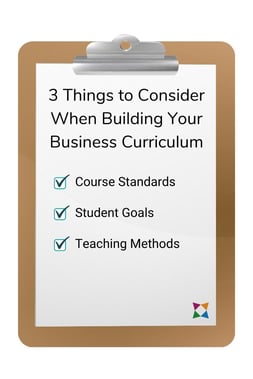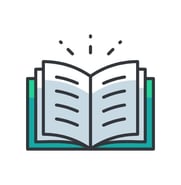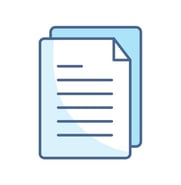Looking for new lesson plans and ideas for your business education classes can overwhelm any teacher. Your plans are the foundation of your students’ learning experience, so you’re concerned about using the right resources to provide your students with the knowledge and skills they need.
With so much material to cover, course standards to meet, and little time to plan and prepare, you need to quickly find high-quality materials for your classes.
In our experience working with teachers like you, we’ve found four common reasons business teachers look for new lesson plans.
To help you find exactly what you need, click below to jump to information in this article that is most relevant to you:
In this guide, you’ll find some of the best places to refresh your lesson plans with resources that are up-to-date, engaging, and easy to implement. We’ll also discuss the consequences of continually looking for new lesson plans and resources and help ensure you always have quality business education resources at your fingertips.

What To Do If You Have No Materials To Teach Your Business Classes
Your school is expanding its business education offerings, and you’re in charge of teaching a new course. Suddenly, you have the daunting responsibility of coming up with an entire curriculum on short notice, and you have no idea what materials your students will need to succeed.
If you’re in this situation, the task before you can feel ominous and scary. If you aren’t able to find materials quickly enough, you run the risk of your class becoming a total disaster.
You want to locate enough exercises and activities to create lesson plans as soon as possible. And it’s essential to choose the right resources from the beginning. You’re not alone in feeling this way; many other teachers have been in the same situation.
To help you get started, we’ll answer four common questions teachers have about building a business education curriculum:
- What Should I Consider Before I Get Started?
- How Do I Create Effective Lessons?
- What Materials Do Other Teachers Use?
- How Do I Choose A Good Teaching Resource?
By understanding the answers to these questions, you’ll be able to effectively evaluate which materials are suitable for your business courses.

What To Consider Before Creating Lesson Plans and Building Your Business Curriculum
Before diving in and creating your lesson plans and curriculum, you should consider the big picture of what you are teaching and how you’ll achieve success.
Three things to consider before building your business curriculum are:
- Your course standards
- Your students’ goals and outcomes
- The teaching methods you will use
Below, you’ll learn why you should keep each of these in mind as you create your lesson plans.
Consideration 1: Your Course Standards
Before choosing what materials you want to use, the first step is knowing what you need to teach. The best place to start is your course standards, which are usually published by your state department of education or another accrediting body. Many business education course requirements are based on the National Business Education Association (NBEA) standards, which can be a great starting point for you to reference.
In addition, connect with your administrator or program coordinator for more information on your specific course requirements. When you look at the requirements you are responsible for meeting, you can gain a better understanding of the steps you need to take to meet your standards.
Remember, course standards are the most critical content you need to cover, so starting with your standards ensures your lessons prioritize the essentials.
Consideration 2: Your Students' Goals and Outcomes
After reviewing your standards, it’s critical to consider the student outcomes you want to achieve. Every task should be designed to move your students forward in the learning process.
One key objective in many business classrooms is preparing students for a certification test. Business certifications have become increasingly common and demonstrate the scope of a learner’s knowledge and skills in business.
Some common certifications teachers incorporate in business courses are:
If your students will take a certification exam, you need to ensure your lessons will set them up for success in preparing. Since you are responsible for tailoring your instruction to these certifications, it’s a good practice to think about how every unit, lesson, and activity connects to these learning goals.
Consideration 3: The Teaching Methods You Will Use
Once you determine what you need to teach, you should think about which teaching methods you plan to employ.
Some teaching methods commonly used by business teachers include:
- Lecture-based instruction
- Classroom discussions
- Hands-on activities
- Project-based learning
- Student-led instruction
- Formative assessments
Although it is possible to rely on a single type of instruction for the entirety of your class periods, this is usually not the most effective way to reach all of your students. Instead, teachers have found that when they include a variety of active-learning exercises and techniques, they can better enhance their students’ learning process.
Overall, the methods you want to incorporate can help you determine what materials to use when building your business curriculum. The exact elements you choose for your lessons will depend on the type of course you are teaching, your standards, and the particular needs of your students.
How Do I Create Effective Business Lessons?
c311.jpg)
Now you know what you want to keep in mind when building your curriculum. But you might be wondering how you actually go about creating good business lessons. In this section, you’ll learn how you can make lessons that set your students up for success.
Fundamentally, a good business lesson is one that successfully communicates and reinforces critical concepts to ensure every student learns and grows within your class.
Educators often have different perspectives on how to quantify a good lesson, but ultimately the best lessons effectively engage students and help them master the course material.
Thankfully for teachers and students, there is not just one type of good lesson. Instead, an adept educator uses blended learning to provide effective instruction to students.
Blended learning strategies combine time-honored classroom learning techniques with digital resources. By engaging learners in different ways, blended learning helps students better retain and master course material over time.
Here are a few different types of lessons business education teachers can use to provide quality, varied instruction to their students:
- Teach compelling class lectures that engage students during their initial period of learning course material.
- Once students are familiar with the concepts of a particular unit, use discussion periods to allow learners to consider course material and ask questions.
- Create compelling lessons using interactive exercises that prompt students to immerse themselves in the course material further.
- Institute learning games and review exercises to reinforce knowledge and prepare for course exams.
- Implement a curriculum system to teach fundamental concepts, and reinforce that information in class lectures to further solidify student understanding.
Mixing instructional methods can help you reach students with different needs and learning preferences. By using active learning techniques instead of relying solely on passive learning situations, you can help your students better comprehend content throughout an entire unit.
Regularly varying the type of lessons you employ helps create an environment where course material is reinforced, and every student can succeed.
When implemented successfully, blended learning strategies can foster a highly effective learning environment for students.
 Want to learn more about blended learning?
Want to learn more about blended learning?
Download this free guide to find four strategies you can easily implement in your classes.
Discover Strategies to Implement Blended Learning >
What Materials Do Other Teachers Use When Building Their Business Lessons?
When looking for new business education materials, it’s common to wonder what other teachers use. Business teachers like you find success with several different types of resources.
The most popular types of business education teaching materials are:
- Textbooks
- Supplemental Materials
- Digital Curriculum
Below, we’ll discuss the pros and cons of each one to help you determine which is right for your needs.
Business Education Textbooks
Textbooks are a reliable option for teachers who want a complete curriculum they can follow for an entire course. With a textbook, you have access to complete lesson content for students along with related assignments and activities. Many textbooks also include a teacher’s edition with lesson plans to guide your instruction and engage students.
The biggest drawback of using a textbook is that your text eventually becomes outdated. Some teachers have also found that their students perform best when they augment textbook resources with supplemental exercises and activities. For technology-related topics in particular, educators have discovered that they need to look beyond a traditional text.
However, textbooks remain incredibly valuable in providing teachers with everything they need to teach their courses, making them a great fit for many business classrooms.
Supplemental Business Education Teaching Resources

Supplemental materials play a significant role in many business education classrooms. These resources often take the form of individual lessons or activity ideas found on forums or marketplaces like Teachers Pay Teachers (TpT). Teachers often turn to supplementary material to add to their existing curriculum or construct lesson plans from scratch.
The biggest strength of supplemental resources is that they allow teachers to have maximum control over the content of their courses. An adept educator can bring together outstanding resources from various providers to create an excellent learning experience for students.
Teachers who want to build a business education course or program that uniquely meets their standards have been highly successful with supplemental materials. On the other hand, it can be very time-consuming to assemble lesson plans, activities, and assessments using supplementary materials. Doing so requires a substantial commitment from teachers to create the curriculum they need.
Digital Business Education Curriculum

A third option many instructors choose for their business education classes is digital curriculum. A digital curriculum system is a software based blended learning option that saves teachers time while providing a variety of teaching materials.
Digital curriculum allows teachers to save time with planning and grading by providing a comprehensive set of teaching materials. It’s also adaptable to a blended learning environment, allowing teachers to make the most out of valuable classroom time while using technology to engage students with course content. Digital curriculum is also continually updated, keeping course content current with changing standards and technological innovations.
One of the drawbacks of digital curriculum is that although it can allow for more flexibility than some textbooks, it lacks the complete customizability of using supplemental resources. However, it can be the right fit for teachers who want a continuously updated curriculum to meet their students’ needs.
How Do I Choose a Good Teaching Resource?
Choosing teaching resources for your students is paramount to your work as a business educator. With textbooks, supplemental materials, and digital curriculum each having their pros and cons, you may be concerned that you are making the right choices.
Which teaching resources are right for your learners will depend on several factors. Consider what types of materials your students find engaging, the amount of time you have to teach a particular topic, and the issues you must cover to satisfy your course standards. You’ll also want to consider how all of your teaching materials fit together to create your course curriculum.
Just as there are many different subjects you may teach in your business classes, there are plenty of reputable providers you can turn to for quality lesson plans and activities.
 Ready to build your business curriculum?
Ready to build your business curriculum?
Jump ahead to popular teaching resources for common business education topics you can use right now.
Find Business Lessons for My Classes >

What To Do If Your Business Education Curriculum is Outdated
If you’re new to teaching business education in your school, you may have inherited lesson plans and teaching materials left by a previous instructor. It’s always great when departing teachers leave materials behind for the next instructor. However, not all of this content may be current or relevant to your students today.
Chances are, if you’ve been using an older curriculum, some or all of the material is outdated. The lesson plans may refer to software that your school no longer uses or emphasize aspects of business that no longer align with your standards. Either way, you’ll need to update your curriculum, or you and your students could face the consequences of outdated materials.
What are the Consequences of Outdated Materials?
An outdated business curriculum can have severe consequences for your students’ success in learning information and performing at their best on exams and certifications.
If you’re teaching with outdated materials, it may result in one or more of these issues in your classes:
- Students who receive outdated or inaccurate information might not pass certification tests that will help them in their careers.
- If students tell others they think your course is dated or irrelevant, enrollment in your program could drop.
- Dated materials may not align with new course standards, resulting in not hitting your teaching requirements.
With such high stakes for you and your students, it’s paramount that every classroom uses current, accurate, and relevant resources.
How Do I Even Begin to Fix My Outdated Business Lessons?
When facing outdated lesson plans, you might find the task of improving them to be daunting and even stress-inducing. Where do you even start?
The first step to revising or replacing outdated content is to audit the amount of material that is genuinely outdated. A simple way to do this is to look at your entire curriculum for each course you teach.
When conducting a curriculum audit, review your materials to see how your lessons have been affected and note whenever:
- Your content no longer meets course standards
- Your content is inaccurate or irrelevant
- The technology in your classroom has changed
Surveying these signs of outdated educational resources is an effective way to ensure every unit in your classes is relevant and ready for teaching.
As you complete your audit, note every time your resources include dated information. Use your best judgment to determine whether an example or activity is relevant to your current students.
What Do I Do if Only a Small Portion of My Lessons Are Outdated?
After you’ve finished auditing your curriculum, you may discover that only a few of your lessons are out of date. Most of your curriculum is ready for your students, but there are places you can tweak your lessons to make sure they are current.
In this case, you can easily address your problem by finding replacement lessons for material that is no longer up to date. When you locate new, timely lesson plans, you can integrate them into your curriculum to seamlessly bring your course up to date.
This technique is also helpful when you experience minor changes to your course standards. You can simply locate quality lesson plans to cover new standards and add them to your existing instructional materials.
a7f3.jpg) Need a few lessons to replace your existing ones?
Need a few lessons to replace your existing ones?
Jump ahead to popular business education lessons you can use to replace your outdated content.
Find New Business Lessons for My Classes >
What Do I Do if Most of My Business Lessons Are Outdated?
Replacing outdated course content can be overwhelming for many teachers, but it’s important to find resources that provide what your students need. When you’ve finished reviewing your lesson plans, if you find that all or most of your materials have become outdated, you should consider a more comprehensive solution to replace your dated curriculum.
If the majority of your materials are outdated, the most straightforward way to bring your content up to date is to replace your curriculum entirely.
A brand new curriculum will provide content that adheres to the latest standards, engages students with relevant examples, and saves teachers the time it takes to assemble their coursework by themselves.
Teachers have seen success updating their lessons with a variety of new curriculum options. Two of the most common types of business curriculum are textbooks and digital curriculum systems. Both provide teachers with ample resources to teach business education courses and can help any teacher provide a more up-to-date, comprehensive curriculum.
 Wondering whether textbooks or digital curriculum is right for you?
Wondering whether textbooks or digital curriculum is right for you?
Download your free comparison guide to find out.
Digital Curriculum vs. Textbooks: Which Is Right for You? >

What To Do If Your Business Lessons Aren't Engaging
You know the struggle of dealing with students who aren’t engaged. You’ve worked hard to prepare for class and are teaching with as much energy and enthusiasm as you can muster. But your students simply aren’t responding. You’re met with blank stares, glances at the clock, and worst of all, dead silence. These are situations that every teacher dreads, and when it happens in your business education classes, it’s easy to feel embarrassed and unsure of what to do next.
Why Is Student Engagement Important?
Student engagement is essential to your classroom. Students who are alert and attentive participate more often, learn more thoroughly, and perform better on exams. When learners engage with your material, you can have more confidence that they comprehend and will remember valuable insights that will help them both now and in the future.
On the contrary, disengaged students miss out on valuable learning through everyday engagement with your course material. When they can’t focus and don’t contribute to discussions, students can’t reinforce the course material in ways that retain knowledge and skills.
Even worse, if your course is seen as boring, your enrollment numbers could decline and result in challenges with your program’s growth.
Ultimately, engaged students are more likely to be successful and ready for future learning and career opportunities.
How Do I Keep My Business Students Engaged?
If you notice that student engagement is dropping in your classes, you’ll want to grab their attention as quickly as possible.
For a quick fix to your engagement challenges, try one of these student engagement strategies for business classes:
- Use relatable situations and examples that feel relevant to students’ everyday life. Choosing examples students understand makes learners more likely to feel as though they have agency in the learning process and contribute to class discussions.
- Promote active learning over passive learning to encourage students to get involved in classroom activities. Dynamic learning exercises help reinforce course concepts through differentiated instruction and allow students to better connect with the material.
- Add role-play activities to mix things up and help students engage creatively with course material while developing critical soft skills. Students can develop public speaking, interviewing, and customer service skills, all while participating in fun classroom exercises.
- Incorporate project-based learning into your program so students can create original ideas and express themselves. Projects help students reinforce content learned in class while working as individuals or groups.
- Use a "hook", also known as an anticipatory set, to get students' attention. There are many forms this can take, but one of the most tried and true is to begin class by sharing a story that both interests students and primes them for the lesson of the day.
- Deliver lessons through multimedia to engage your students' senses on several different levels. Combining images, words, and sounds in a meaningful way can foster a deeper learning in students than simply having them read from a textbook.
- Try blended learning as a way to incorporate digital and traditional teaching methods. Blended learning allows students to get the most out of classroom time while using technology to learn and retain critical information.
While these strategies can help you boost engagement in the moment, if you find yourself constantly looking for new ideas and activities, chances are that your curriculum might be letting you down.
The best remedy to keeping your students active in your class is teaching from material that is engaging and relevant. Still, when you use more relevant and captivating resources, you won’t have to do as many things in your day-to-day instruction to boost student engagement.
If your material is compelling to your students, you won’t need to do as many extra things to boost engagement in your classroom. This is why it’s important to make sure you have the right curriculum resources for your classes!

Where to Find Business Education Lesson Plans and Curriculum Resources
As a business educator, there is a good chance that you need to teach a wide variety of topics. Since business education encompasses many important subject areas, you might be concerned about finding the right lesson plans for all of the concepts you need to cover. Thankfully, there are many great resources available for teaching classes in your business program.
Below, you’ll find popular resources to help you teach 12 common business education topics:
Keep reading to find quality, engaging business education lesson plans for your courses!
 Accounting Lessons
Accounting Lessons
Accounting is one of the most common business education classes for high school students and a popular college major in the business career cluster. We often get questions from teachers about what accounting exercises and activities we would recommend for their students.
Refer to this article to find details about popular resources you can use: Top 3 Accounting Lesson Plans for High School. In this post, you’ll find details about three free, quality sources for accounting lessons, including the specific topics covered by each.
If you want a resource on accounting principles that you can use right now, download this free accounting lesson plan. This resource features presentation slides and speaker notes and can be used easily with your current accounting materials.
And if you teach in the middle school space, another article to check out is: 4 Best Accounting Lessons Plans for Middle and High School, which should cover many of your bases.
 Business Law Lessons
Business Law Lessons
Business law is a topic that can provide valuable knowledge and skills for students aspiring to careers in the business world. Although it’s a broad topic area, introducing students to business law concepts and principles can help them prepare for management, finance, and legal compliance jobs.
This article addresses some of the top business law lesson plans for high school. These lesson plans are helpful for teachers who want to give their students context on different aspects of the legal system as it pertains to business, including tort law and criminal law.
If you need materials to teach business law, check out these resources to see if one would work for your course.
 Career Readiness and Exploration Lessons
Career Readiness and Exploration Lessons
One of the first steps for business education students is learning about career development. Career development, which includes career exploration and career readiness, is essential to ensuring students are aware of work opportunities and the skills and qualities they will need to achieve their goals.
If you’re teaching career exploration to a younger audience, check out the best career exploration lesson plans for middle school. These resources introduce students to the possibilities of working in various careers and will help inspire them to dream big in their work aspirations.
In addition, these career readiness lesson plans will help your students learn what today’s employers are looking for and how they can achieve their goals. Teachers can also scaffold these resources to students at different grade levels to provide an optimal learning experience.
If you want a free resource that you can use right now, download this career exploration lesson plan and activity. It includes guidance to help students identify possible career choices as well as the steps necessary to achieve their goals.
 Communication Lessons
Communication Lessons
Fluent communication skills are essential for individuals seeking business success. Developing these skills early on ensures that students have the best possible opportunity to rise to the occasion and prove their value to potential employers.
Finding resources to teach these skills isn’t easy, but other teachers have discovered this same problem and created valuable resources for teaching communication in the classroom. This post includes the 3 Best Resources to Teach Communication Skills in High School. Each resource comes complete with lesson plans, activities, and materials you need to teach communication.
If you’re teaching younger learners, the 3 Best Communication Lesson Plans for Middle School will help acquaint your students with the fundamentals of good communication.
 Computer Applications Lessons
Computer Applications Lessons
Some business teachers need to include computer applications in their curriculum. Understanding basic computer applications allows your students to be prepared for the many computing tasks they will often be required to complete as part of their education and future jobs.
If you’re looking for general computer applications resources, the 5 Best Computer Applications Lesson Plans for High School feature teaching plans for an array of age-appropriate applications.
However, you may need something more specific to the suite of computer applications your students are using.
If you’re searching for content specific to teaching Google Apps, here are Google Applications Lesson Plans Every Teacher Should Own.
If you need materials for Microsoft Office applications, check out the 4 Best Microsoft Office Curriculum Resources for Middle and High School.
 Digital Literacy and Citizenship Lessons
Digital Literacy and Citizenship Lessons
Digital literacy is an increasingly important topic for teaching students discernment in a world full of media content and conflicting ideas.
You can help your students develop appropriate skills for evaluating information online with resources in this article: How to Teach Digital Literacy Skills.
In addition, these digital citizenship lesson plans empower students to learn effective digital communication, combat cyberbullying, and maintain their privacy online.
 Economics Lessons
Economics Lessons
There’s a good reason why economics is one of the most popular business education subjects taught in today’s high schools. An appreciation for the greater economic system is pivotal in helping students become competent money managers in their professional lives.
If you need more materials to teach this topic, look into the Top 3 Economics Lessons for High School.
These lesson plans are perfect for educators looking for ways to introduce students to the fundamentals of macroeconomics and microeconomics. They also include roleplay scenarios and online learning features.
 Entrepreneurship Lessons
Entrepreneurship Lessons
Entrepreneurship is a popular elective in high school business programs. When you teach entrepreneurship, you can encourage your students to follow their aspirations in business through understanding the unique role and challenges of the entrepreneur.
There are some great resources out there to help teach entrepreneurship in your classes. To begin, check out the 4 Best Entrepreneurship Lesson Plans for High School. These materials range from simple lessons to cover just a couple of class days to more robust curriculum designed to last an entire course.
If you’re looking for additional resources, be sure to check out these additional entrepreneurship lesson plans. Each of these lessons will help you think outside the box and teach entrepreneurial skills to your students in a creative way.
 International Business Lessons
International Business Lessons
Increasingly, high school teachers are looking for plans to teach international business to their students. The way business happens on a global scale is changing, and you need up-to-date information to keep your classes current.
This post provides five places to find international business lesson plans for high school. Inside, you’ll find reviews of resources that teach important international business concepts, such as international management, ethics and social responsibility, cultural differences, and etiquette.
These lesson plans come with interactive case studies, websites, exercises, and simulations to keep your students attentive and engaged.
 Leadership Lessons
Leadership Lessons
Leadership, including related capabilities such as communication, character, worth ethic, and critical thinking, is one of the most important qualities to cultivate in business students. While skilled managers help to run businesses, true leaders help them thrive and bring them to new heights.
There are strong leadership lesson plans out there to help you teach this essential topic to your business students. Included are activities, handouts, teacher's guides, and other materials to help you implement this instruction in your classroom.
With these resources, your students will both learn about and practice leadership skills so that they can guide a new generation of businesspeople to success.
 Management Lessons
Management Lessons
Agile and perceptive management is an essential element of every thriving business. Developing sound management skills at an early age helps students prepare for work in business and sets them up to be respected and admired leaders.
Management is also one of the most common topics instructors need to cover in high school business courses. Unfortunately, it can sometimes be hard to find materials that learners find relevant and engaging. To help, we’ve brought together the top business management lesson plans for high school. Each of these resources includes detailed outlines and techniques for effectively teaching management to a young audience.
If you want help teaching effective leadership, the 4 Best Leadership Lesson Plans for High School reviews quality resources for developing student leaders. These lessons allow students to explore the qualities of a good leader and encourage them to cultivate these qualities in their own lives.
 Marketing Lessons
Marketing Lessons
Marketing can be one of the most exciting business subjects for students when taught in an engaging manner. Many teachers are searching for new methods for teaching marketing to pique the interest of their students.
The 7 Best Marketing Lesson Plans and Projects for High School include teaching materials ranging from supplemental marketing lessons to full-fledged marketing courses. When you read the article, you’ll learn more about each option to determine if one is suitable for your students.
Another excellent resource for marketing lesson plans is CTE Online, a career and technical education curriculum provider. CTE Online offers a 180-hour marketing course for teachers looking to cover the subject over an entire academic year.
If you teach the basics of marketing and want a lesson to use immediately, download this free principles of marketing lesson presentation. This free resource features prepared slides and speaker notes that discuss customer relationships, market segments, the value of marketing, and more.
 Personal Finance Lessons
Personal Finance Lessons
Middle school is the perfect time to begin instructing learners about responsible money management. Knowing how to manage personal finances is critical to helping students become sound money managers who have the foundations for financially solvent lives.
The best personal finance lessons for middle school feature complete resources to educate students about money management, credit, loans, and even consumer privacy.
If you're looking for more a robust curriculum, check out these financial literacy curriculum options for middle school.
 Professionalism Lessons
Professionalism Lessons
Whether it's learning how to dress, how to be approachable, or how to make a good first impression, professionalism is a critical skill in the modern job market. Learning the strategies to thrive in a professional environment will benefit students almost no matter what field they choose to go into.
Often, professionalism lesson plans can be tough to find, since they're usually focused on training new employees rather than high school students. If you're looking for some robust ones, though, these high school professionalism lesson plans will help you teach concepts like teamwork, communication, bringing the right attitude, and even having a good wardrobe.
If you're looking for a quick lesson to teach this topic, check out this free downloadable professionalism lesson plan and activity. It includes resources like instructions, scenarios for students, and discussion questions.

Consequences of Focusing Solely on Business Education Lesson Plans
In the section above, we looked at resources for the most common topics teachers like you cover in their business education courses. Whether you’re teaching a new topic area or updating your content with something new and more engaging, any of these resources could be just what you need to fill a gap in your curriculum.
These supplemental resources are perfect for teachers looking to solve particular problems with their curriculum, but they aren’t a comprehensive solution.
Have you found yourself searching for additional lesson plans, again and again, to meet an immediate need in your classroom? Did you complete an audit of your curriculum only to discover that most of your materials have become irrelevant and out of date?
If so, continually searching for new lesson plans, activities, and other classroom materials may be costing you more than you realize.

Three of the biggest consequences of constantly looking for new lesson plans are:
- Spending your nights and weekends scrambling for new materials
- Struggling to create a cohesive learning experience for your students
- Discovering your favorite materials are outdated or no longer available
Consider the number of hours you’ve spent navigating the internet in search of replacement resources, only to use more time integrating your newfound content into your existing lesson plans.
Lost time strains your ability to handle other expectations like grading and working individually with students. You might also find yourself with less time to spend with your family or rest outside of school.
In addition to consuming a significant amount of time, we’ve heard from teachers who’ve shared other challenges in relying on supplemental resources to build their curriculum.
When students receive lessons and assessments from a variety of sources, they can experience a lack of instructional continuity within the course. This can be quite jarring when instructors jump around from various resources on a weekly or daily basis, leaving students confused about the most essential concepts of the class.
Other teachers have become disappointed and frustrated that the resources they’ve relied on suddenly become outdated, leaving them to replace these resources on an individual basis.
When tried-and-true resources aren’t current, or are no longer available on the internet, you’re left to search again. This cycle of replacing even the best supplemental resources can repeat itself, costing you even more time when you can least afford to spend it.
Ultimately, lesson plans only constitute the tip of the iceberg for supplying your business students with a comprehensive curriculum that will help them learn and grow. You also need effective projects, course assessments, discussion sections, and other resources to truly have a curriculum that meets your standards and keeps your students engaged.
To provide students with everything they need while saving yourself time and energy, consider a solution that will keep all of your curriculum current and engaging.
Overcome Your Challenges as a Business Education Teacher
Are you tired of searching for new lessons week after week, only to feel overwhelmed with your other responsibilities as a teacher?
Want to feel less overwhelmed and spend more time helping your students succeed? There are many strategies to help you do just that.
Read this free guide to discover how to overcome five common challenges:
- Satisfying Your Course Standards
- Meeting Diverse Student Needs
- Keeping Students Engaged
- Balancing Technology in the Classroom
- Spending Too Much Time Planning and Grading
After reading, you’ll save time while feeling more confident about managing your business education classes.


c311.jpg)






a7f3.jpg)






